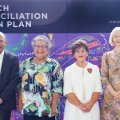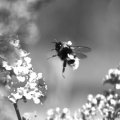A new $600,000 laboratory at the University of Queensland is helping the world's mining companies to date rock samples and plan exploration programs.
The laboratory represents the most recent addition to the world class isotope geochemistry facilities in the University's Earth Sciences Department.
Using latest technology, including an ultra-high vacuum extraction line and a Mass Analyser Product mass spectrometer, the Ar Laboratory can now accurately date a rock or mineral sample in just 20 minutes. Previously, it took 24 hours.
The laboratory is fully automated so can be run by one person - in this case laboratory head and Department lecturer Dr Paulo Vasconcelos - and programmed to analyse up to 221 different samples for up to five months without further intervention.
The laboratory automation also allows it to be run remotely. With a lap-top computer and modem, the whole system can be controlled from anywhere on the planet.
Laboratory equipment measures the abundances of isotopes of noble gases, primarily argon (Ar), trapped in minerals to determine when the rocks were formed. A geologist can then construct an area's geological history. This information is used to determine the suitability of an area for the exploration of specific types of ore deposits.
Noble gases include argon, neon, helium, xenon, radon and krypton. Argon is a common product of the radioactive decay of potassium and is relatively abundant in most rocks.
The amount of argon present in a rock or mineral sample is a reliable indicator of a rock or mineral's age because of argon's inert nature - it does not engage in usual chemical reactions with other elements and is quantitatively retained in the host rock or mineral.
When a sample is irradiated in a nuclear reactor, the potassium content can be measured indirectly by the abundance of the 39Ar isotope generated. The ratio of natural radiogenic 40Ar to the nucleogenic 39Ar provides an age for the sample. This dating method is known as the 40Ar/39Ar technique.
'Valuable substances such as gold and oil tend to be hosted by rocks of a specific age,' Dr Vasconcelos said.
'We establish ages of samples through our equipment and these results, in combination with other indicators, helps exploration companies decide whether a particular area is likely to host the desired ore deposit. Our system provides a relatively inexpensive way to determine if further, more expensive exploration techniques should be used or if the area is unlikely to host ore deposits of a particular commodity.'
Originally designed to analyse lunar material, the laser-heating gas extraction technique used in the laboratory can date suitable samples (potassium and argon-rich rocks and minerals) as young as 2000 years old or as old as the Earth itself - an estimated 4.56 billion years.
'In addition to the applications in exploration for ore deposits, the high analytical precision and wide range of time dated by the method makes the 40Ar/39Ar technique ideally suited for nearly all geochronological applications,' Dr Vasconcelos said.
Currently, Dr Vasconcelos is dating the formation of weathering profiles in northern Queensland. The ages of the minerals which precipitate when rocks are oxidised and leached by rainwater provides information about ancient climates.
'This information is essential in understanding the evolution of the surface of the planet, and crucial in determining the suitability of past environments for living organisms,' Dr Vasconcelos said.
Dr Vasconcelos and Earth Sciences Department Head, Professor Ken Collerson, will also be dating the formation of volcanic rocks in northern Queensland. Professor Collerson said these volcanic flows were very young and difficult to date by other methods.
'With the application of the 40Ar/39Ar method, we will be able to accurately and precisely determine the ages of extrusion. This information will be used to determine the recurrence rate of volcanism in the region,' Professor Collerson said.
The laboratory is one of only three in Australia and was built using $200,000 from the University's Group Development Fund, a two-year, $280,000 Australian Research Council (ARC) Large Grant and $100,000 from various mining companies and other sources.
Dr Vasconcelos also has a three-year, $188,000 ARC Large Grant to develop new techniques using the laboratory's equipment for the analyses of minerals precipitated by low-temperature geological processes.
According to Dr Vasconcelos, the laboratory, commissioned in May 1997, is already well on the way to paying for itself with samples being analysed for mining companies throughout the world.
Researchers from academic and research institutions in Australia as well as the United States, China, France, Brazil, Chile and the United Kingdom regularly request and invite research collaborations.
Irradiated crystals from each sample are first placed in small pits on a copper disc. Individual samples are then heated to temperatures of between 250 and 2000 degrees Celsius by a 10W argon ion laser.
Gases emanating from the sample are separated through various techniques including a crycooling device and special pumps to leave the desired noble gas isotopes. These are then ionised in a hot filament source, accelerated through a magnetic field, separated into the different isotopes and their relative abundances measured by an electron multiplier in the mass spectrometer collector.
Sample degassing, gas and cleaning procedures, and mass spectrometric analyses are controlled on-line through a computer system. A sample age is determined with 10 to 20 minutes after gas extraction.
Data interpretation, using pertinent geological information and the analytical results, is provided by Dr Vasconcelos.
For more information, contact Dr Vasconcelos (telephone 07 3365 2297).



